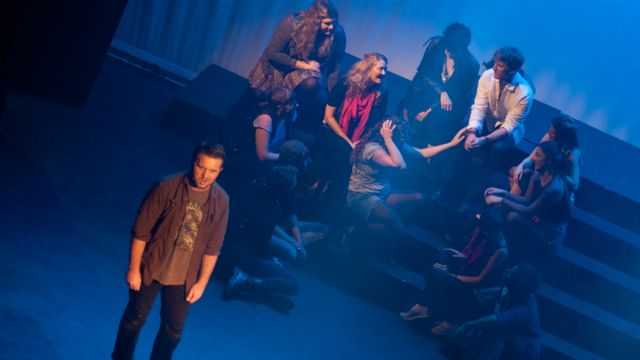Jesus Christ Superstar
After travelling to Sydney’s extremes for two community theatre productions of rock opera Jesus Christ Superstar in ten days, the big plus is that I was rewarded with two very distinct directorial visions.
The rock opera sparked outrage and protests outside theatres in the 1970s; not surprising with its depiction of Christ’s story using ‘the Devil’s music’, an implied sexual relationship with Mary Magdalene, drunken disciples at the Last Supper and an ending with no resurrection.
Checking out Manly Musical Society’s program pre-show, against-gender casting grabbed my attention, with priest Annas and King Herod to be played by women. Were these choices down to community theatre’s too frequent lack of males. Certainly there weren’t going to be 12 male disciples either. No, I discovered later. These were deliberate choices, while an even more radical one had been contemplated initially.
Did the casting work? Yes, but more of that later.
As the lights went down and the band began playing, the familiar rock music from their enclosed pit sounded more subdued than expected, then as the vocals began, it became clear this was a softer rock interpretation than usual more like you’d expect from, say, Godspell. (Audience members I’d over-heard grumbling about the noise levels at the Engadine’s production ten days earlier would have been delighted.)
 Rather than the usual full-on rock’n’roll confrontation between Jesus and Judas, this feels more like conventional music theatre; the disagreements are milder, and the storytelling generally gentler. If there is aggression, it comes from a protective Mary, in a portrayal where her relationship with Jesus goes more for loyal friend than sexual undertones. Thomas Adams (Jesus), Anthony Swadling (Judas) and Olivia Aleksoski (Mary) have voices well-suited to their roles in this soft rock interpretation, and their characters are well-drawn. In his brief cameo as Simon, Leon Huxtable probably displays the most conventional rock’n’roll chops of the night.
Rather than the usual full-on rock’n’roll confrontation between Jesus and Judas, this feels more like conventional music theatre; the disagreements are milder, and the storytelling generally gentler. If there is aggression, it comes from a protective Mary, in a portrayal where her relationship with Jesus goes more for loyal friend than sexual undertones. Thomas Adams (Jesus), Anthony Swadling (Judas) and Olivia Aleksoski (Mary) have voices well-suited to their roles in this soft rock interpretation, and their characters are well-drawn. In his brief cameo as Simon, Leon Huxtable probably displays the most conventional rock’n’roll chops of the night.
Lack of ensemble microphones may have been a factor in the choice of relatively quieter accompaniment, as the ensemble is often still rather too quiet when placed upstage, without any pit-singing support. Moments when they are brought forward are far stronger vocally.
Early on, a fairly static, neutral ensemble staging gave little intimation of the interesting choices they would participate in later. They seemed like a passive audience gathered around a storyteller, listening intently, on the show’s simple fixed setting of steps and rostra. Motivation for ensemble exits, and continuity, sometimes needed clearer definition.
Casting Keira Connelly as the priest Annas was very effective, establishing an inttriguing through-line for the established religious hierarchy of the piece. High Priest Caiphas usually leads this pecking order, and his throne still symbolizes his official rank, but Robert McKenzie (who has the necessary, familiar bass notes) plays that role as a bit past-it, with Annas firmly in control. It’s the fierce, malevolent characterization of a decisive political operative, and carries all the real authority.
As Pilate, the Roman Governor, William Stavert gives an intense, thoughtful interpretation of the dream. Usually a quieter pause in a rocking, frenetic show, in this Superstar the contrast is less marked, slightly altering the show’s texture.
Early in the second act, Thomas Adams’ outstanding rendition of ‘Gethsemane’ is spine-tingling, and from this moment, as the urgency of the story escalates, so does the creativity of the interpretation.
A symbolic slant on the hanging of Judas (realistic hanging is pretty tough for community theatres who respect safety standards) is probably the highlight, with his torment and death handled in a striking zombie-esque movement and light interpretation. In the title song, Judas is supported by a tremendous ‘rock chick’ backing, costumed in a mix of 60s to 80s styles, though momentarily there’s an attempt to involve just too many of the ensemble.
 The interpretation of the 39 lashes, involving ensemble members, suggests broader society’s role in the torture of Jesus, and will become quite striking if just a little more synchronized.
The interpretation of the 39 lashes, involving ensemble members, suggests broader society’s role in the torture of Jesus, and will become quite striking if just a little more synchronized.
I had my doubts about the against-gender casting of Herod, but none whatsoever about the decisive, entertaining performance of Jessica Priebee in the role. It’s a strong interpretation in its own right, with all sorts of added overtones and nuance, though dancing girls in short, glittering twenties dresses ensure it retains a sexy vaudeville essence.
A potentially great final sequence only falls marginally short at its very end (Spoiler alert if you plan to attend this weekend). As the big title song production number ends, Judas and the cast move forward onto the stage apron as the curtain closes, clearly anticipating a bow when, quite hauntingly, the sound of first nail being hammered into the cross rings out. Their exhilaration suddenly changes, reality sets in, and the curtains open to reveal a striking crucifixion image, reminiscent of circus ribbon performances. It’s too difficult for the performer to sustain for any length of time, and director Carl Olsen has opted not to have a mourning scene, so the curtain closes, and the promising end is ever-so-slightly diminished as we’re left listening to just too much of the bland John 19:41 music, waiting for the bows.
Superstarbroke all attendance records for Manly Musical Society’s five-year history before the production opened, just reward for a young company prepared to make bold choices.
Neil Litchfield
Subscribe to our E-Newsletter, buy our latest print edition or find a Performing Arts book at Book Nook.

